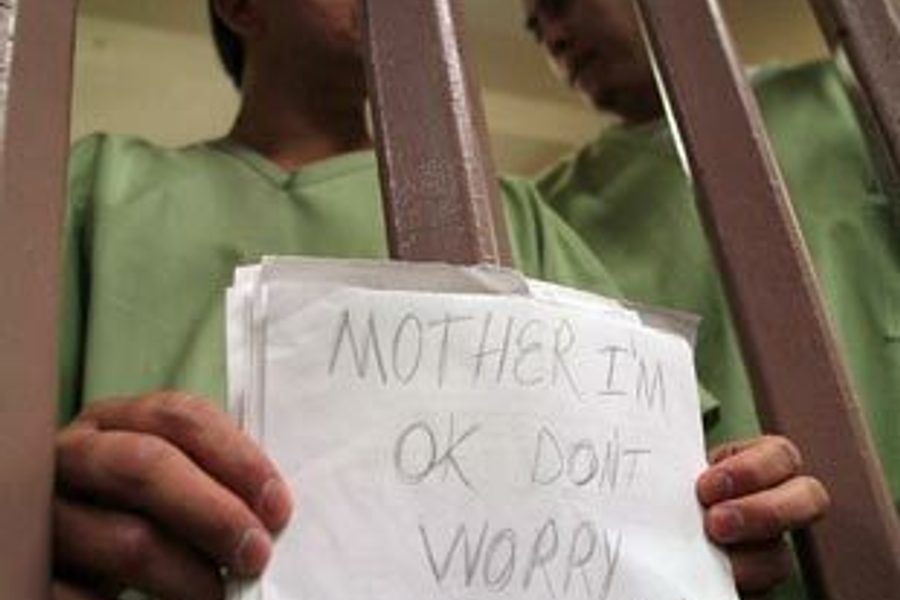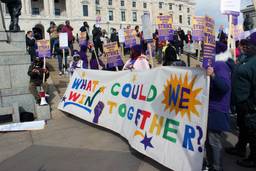
According to two recent research studies, the path that awaits young, undereducated African-American men is more likely to lead them to prison than anywhere else.
In fact, with the expansion of the nation’s sprawling prison industrial complex since the 1980s, things have gotten far, far worse for black men everywhere.
Consider that in 1954 — the year that the Supreme Court weighed in favor of desegregation with their Brown v. Board of Education decision — an estimated 98,000 African-Americans sat behind bars. Today, that figure stands at 884,500, or nine times the number of black men and women incarcerated at the advent of the Civil Rights movement.
Given current trends, one of every three African-American men born today can expect to go to prison in his lifetime. According to the authors of The Sentencing Project’s recent report, “Schools and Prisons: Fifty Years After Brown v. Board of Education,” the situation is largely attributable to the War on Drugs, particularly the grossly disparate crack and powder cocaine federal sentencing guidelines. Despite a U.S. Sentencing Commission recommendation to fully eliminate such sentencing differentials, these guidelines have been supported by both the Clinton and Bush administrations.
Imprisonment is now so common for young men of color that it serves as a veritable rite of passage. And no community has been as badly impacted as African-American inner city neighborhoods, leading to a phenomenon that many sociologists have begun to call the “mass incarceration” of young, low-income black men.
“American society loses the contribution of those men going to prison, in their roles as parents, workers, and citizens,” says Professor Bruce Western, professor of sociology at Princeton University.
Along with University of Washington sociology professor Becky Pettit, Western recently co-authored an extensive research study, “Mass Imprisonment and the Life Course: Race and Class Inequality in U.S. Incarceration,” which was first published in the American Sociological Review. Their study, conducted over a period of several years, demonstrates conclusively that African-American men are now more likely to end up in prison than to earn a bachelor’s degree or even serve in the military.
“I think the findings also indicate an institutional failure,” says Western. “The idea of universal rights of citizenship, social membership, is a central part of American political culture, yet mass incarceration has systematically limited the full participation of low-education black men in American society. Democracy and civil society are diminished and that is a collective loss.”
Pettit and Western’s dramatic findings further demonstrate that fully 60 percent of African-American male high-school dropouts born between 1965 and 1969 ended up doing time in prison by 1999.
These statistics cannot simply be reduced to notions of overt or subtle racial prejudice in arrest, sentencing and incarceration rates, says Western. Access to opportunities plays a key role.
In fact, when Pettit and Western analyzed Census 2000 data, they found that while racial inequalities in imprisonment rates continued at exactly the same exorbitant rate, class and education inequality had become the more significant marker of the American mass incarceration trend. Based on Pettit and Western’s analysis, the lifetime risks of imprisonment for all men roughly doubled from 1979 to 1999, but nearly all of this increased risk was experienced by those who never make it to college.
“Virtually the whole burden of the prison boom has fallen on those with just a high school education,” Western notes.
The Bush Administration has taken a do-nothing approach to the fact that the imprisonment of underprivileged African-Americans has reached epidemic proportions.
On July 23, President Bush stood before the Urban League’s National Convention in Detroit and lauded the diversion of additional funding to federal prosecutors, before asserting that “progress for African-Americans … depends on safe streets.”
The only mention of prisoners during the President’s speech related to the fate of the more than 600,000 men and women who are released from prison each year. “Let’s make sure we’re the country of the second chance,” President Bush told the crowd, without mentioning how his administration would rectify the federally-instituted denial of student loans, public housing, or welfare to any person convicted of a drug crime. (Most states still have such bans in effect, although some legislatures have taken minimal steps to ease the plight of ex-offenders.)
The White House spin, in this regard, seems to be working. Even in this crowd of seasoned civil rights supporters, President Bush’s comments were met with a strong round of applause.








